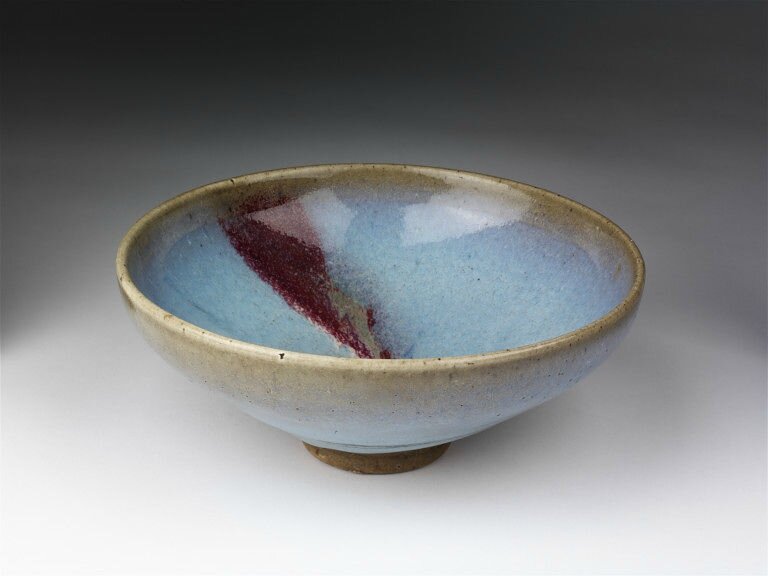Blue glaze and copper-red splash bowl, Jun ware, China, Northern Song-Jin dynasty, 12th-13th century
Blue glaze and copper-red splash bowl, Jun ware, China, Northern Song-Jin dynasty, 12th-13th century. Stoneware, glazed. Diameter: 17.7 cm. Purchased with the assistance of The Art Fund, the Vallentin Bequest, Sir Percival David and the Universities China Committee. CIRC.141-1935 © V&A Images
The bowl on the left of this image belongs to a type of ceramics known as Jun ware. Chinese ceramics are often categorized by the geographical area in which they were made, as the kilns of a particular region usually made only one or two types of ceramics at a given time in history. Jun ware was produced in the kilns of the Henan province and its height of production was during the Song dynasty (960-1279). It can be identified visually by its coarse stoneware body and its thickly applied glaze, which through firing gained an opalescent blue colour. At the edges the glaze ran thin, becoming semi-transparent and creating the simple and elegant colouring of this piece. While some Jun wares use only the blue glaze, it was also common to apply copper brushwork to dry glazes in broad strokes or washes, which then merged with the bluish Jun glazes at full heat. This resulted in the bold splashes of purple-red visible in this bowl.
Some types of Chinese ceramics were made exclusively for the imperial household. Jun wares, however, were mostly made for popular use and were not widely collected before the late Ming dynasty, when they were first mentioned in scholarly writings. By the Qing dynasty their status had elevated, when the Qianlong emperor (reigned 1736-95) was an admirer of them and used them for decorating his domestic spaces.
Bibliographic References: Kerr, Rose. Song Dynasty Ceramics. London: V&A Publications, 2004. p. 34, no. 26.

/https%3A%2F%2Fprofilepics.canalblog.com%2Fprofilepics%2F1%2F0%2F100183.jpg)
/https%3A%2F%2Fstorage.canalblog.com%2F03%2F02%2F119589%2F96711876_o.jpg)
/https%3A%2F%2Fstorage.canalblog.com%2F11%2F31%2F119589%2F94773502_o.jpg)
/https%3A%2F%2Fstorage.canalblog.com%2F20%2F83%2F119589%2F94772815_o.jpg)
/https%3A%2F%2Fstorage.canalblog.com%2F26%2F72%2F119589%2F75604929_o.jpg)
/https%3A%2F%2Fstorage.canalblog.com%2F59%2F60%2F119589%2F26458628_o.jpg)



/http%3A%2F%2Fstorage.canalblog.com%2F05%2F64%2F119589%2F128523518_o.jpg)
/http%3A%2F%2Fstorage.canalblog.com%2F78%2F46%2F119589%2F127133605_o.jpg)
/http%3A%2F%2Fstorage.canalblog.com%2F99%2F82%2F119589%2F126892955_o.jpg)
/http%3A%2F%2Fstorage.canalblog.com%2F51%2F84%2F119589%2F122518624_o.jpg)